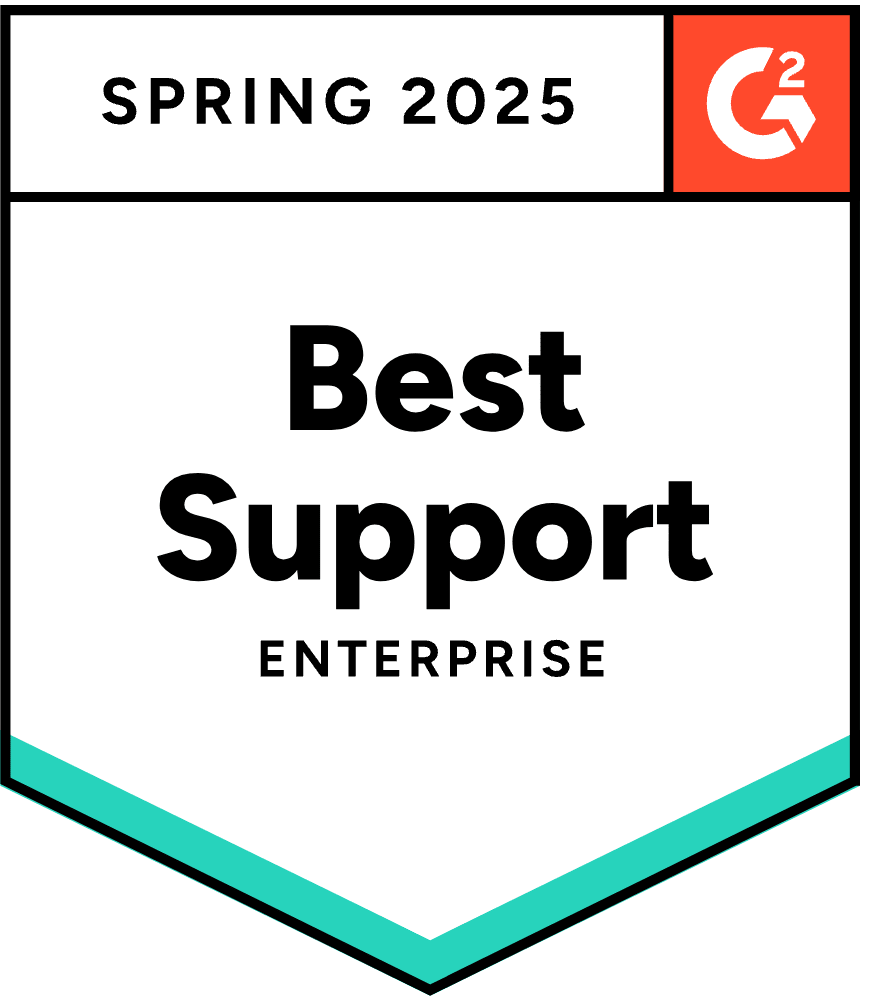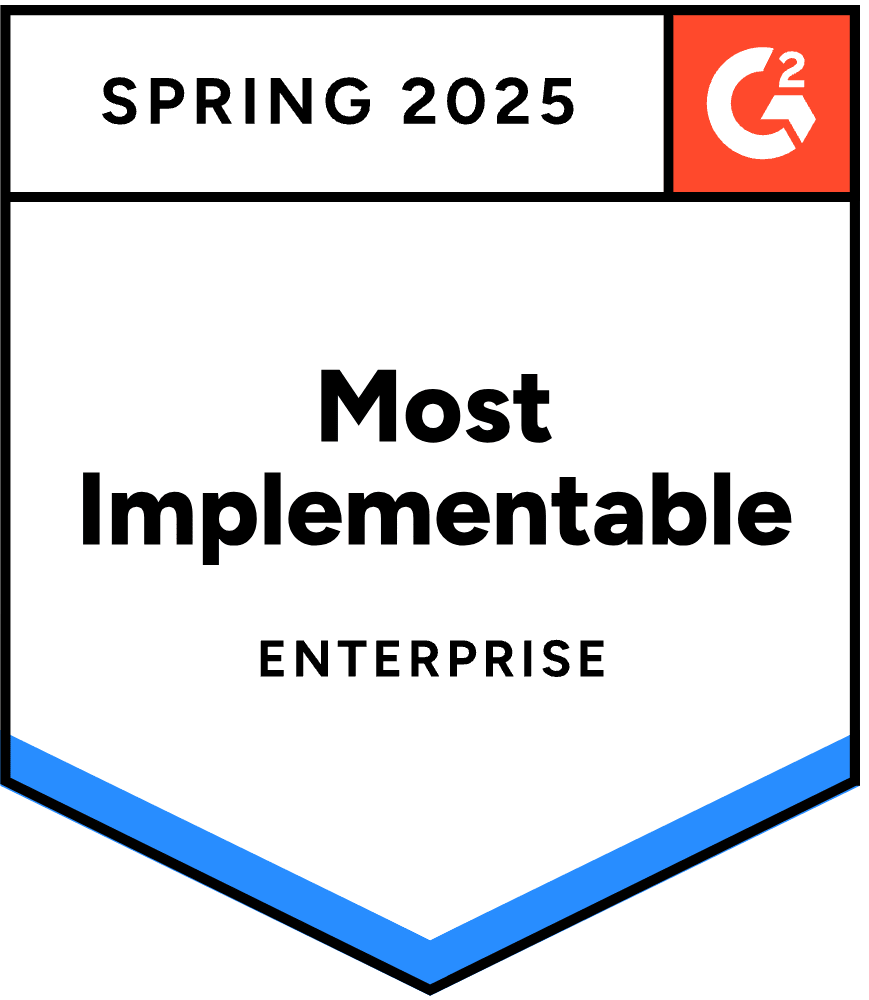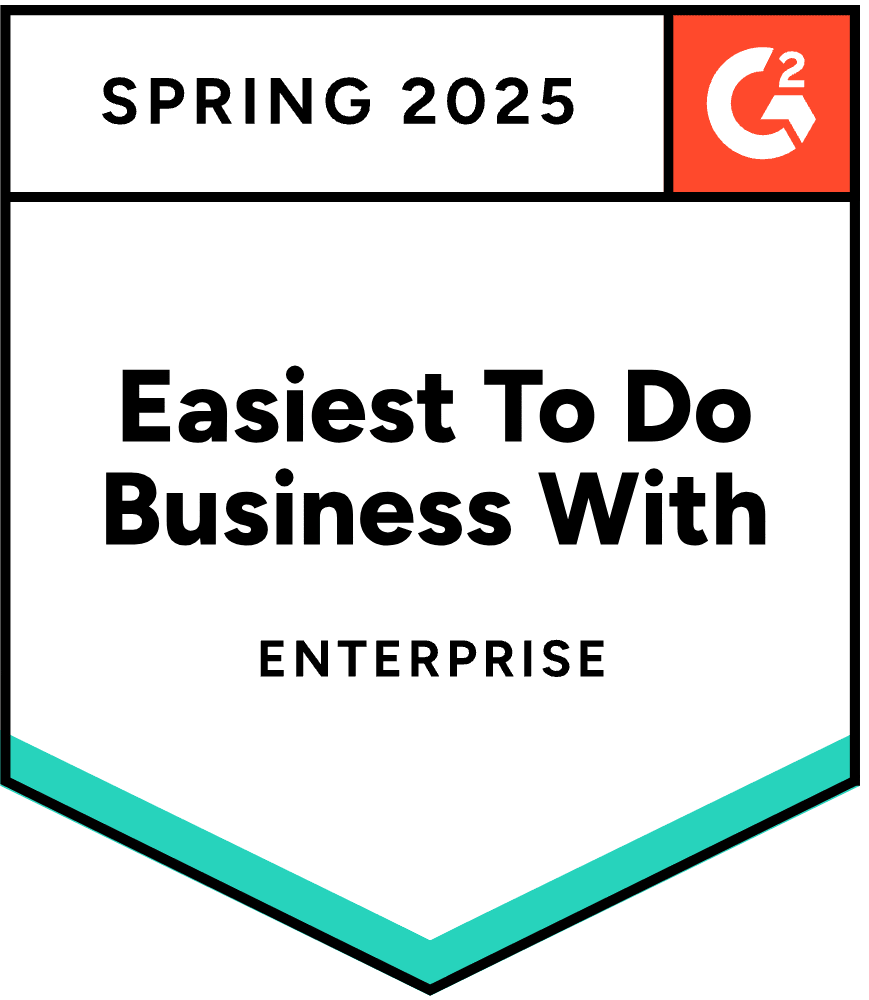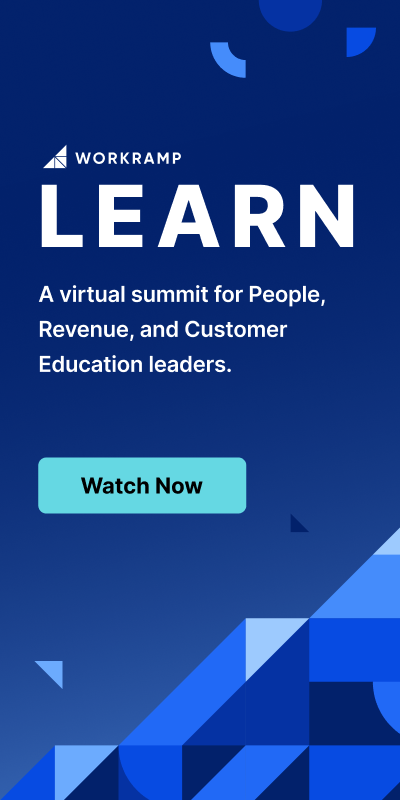18 Types of Sales Enablement Content to Maximize Closed Deals
Maile Timon
View bioLearning Tips Straight to Your Inbox
Close leads; boost sales. Don’t let the inundation of new products and services distract your customers.
With the right sales enablement content, your team can answer questions, address objections, concerns, and pain points, and be the engine for growth, converting prospects into customers.
When sales reps have targeted resources easily customized to the lead, they perform significantly better. The question often is, what kinds of resources should the sales enablement team provide, and how can you ensure it’s easy to find so reps will use it?
Discover the most effective types of sales enablement content and how to arm your reps with the materials they need to succeed.
In this post:
What is sales enablement content?
Sales enablement content includes the resources sales reps can use throughout the selling process, including product information or knowledge needed to convert a sale.
These resources may come from other departments; for example, your marketing team might create an infographic or sales sheet that you include in your email template. Or you might have a list of product features you want all sales reps to discuss with qualified leads.
Reps need the right sales enablement content at the right stage of the buyer’s journey to address prospects’ pain points and concerns.
Sales enablement content is broken down into two categories: internal and external. Internal content is used with sales reps to improve their performance, and external sales content is used with leads to increase their confidence in your solutions and brand.
What is external sales enablement content?
External content is what many people think of when they talk about sales enablement. These are the flyers, sales sheets, testimonials, and more that your sales reps can share with leads.
These customer-facing assets may answer common buyer questions, demonstrate specific benefits of your solution, educate buyers, help them justify the purchase, and more.
Unfortunately, up to 90 percent of B2B sales reps don’t use sales materials because they feel it’s irrelevant, outdated, or too hard to customize for the buyer. Your sales enablement team can significantly impact when they provide targeted, customizable external sales enablement content.
What is internal sales enablement content?
Internally, sales enablement content empowers sales reps to better respond to objections, handle unique situations, and encourage customers to buy. The 2023 State of Sales Enablement report showed that reps who use sales plays to manage various sales scenarios better had increased confidence in their skills and a 3 percent increase in win rates.
Internal sales enablement also involves helping reps understand the customer buying process, teaching them virtual selling skills, helping them add value for leads, and more.
How do you know what content your reps need? Ask them! Feedback from sales reps will improve your sales enablement training considerably, and they’ll be more likely to use and incorporate assets they specifically asked for.
Why is sales enablement content important?
Without external sales enablement content, you’re asking customers to “take your word for it” rather than proving that your product will solve their problems. If the messaging is backed with sources and written or expressed with confidence, your enablement materials build credibility and establish authority on your customers’ issues.
Without internal sales enablement content, you’re asking your reps to “wing it” and figure out for themselves how to apply sales assets to the buying process, which will predictably lead to poorer results.
The best types of content give you a secure foundation to build customer relationships.
“Creating an optimal customer experience hinges on dynamic selling because reps need to align to the customer buying process and arrive prepared to each conversation,” according to Melissa Regan, WorkRamp’s Senior Sales Enablement Manager. “Enablement materials that are consumable, accurate, and relevant equip reps for value-based conversations and will boost reps’ confidence as they navigate each unique customer journey.”
Sales enablement solidifies the customer’s purchase decision by reinforcing that you understand their pain points and how your product can help.
How do you organize sales enablement content?
The best way to organize your sales enablement content depends on your company and creating a solution that equips reps with the content they need when they need it based on where a prospect is in the sales process.
Reps have an average of 1,400 sales assets to choose from, according to Forrester. Still, the taxonomy of available assets has widened, often leading to a disconnect among content producers, managers, and users.
Creating effective sales enablement content is only half the battle; you must also organize it to make it easily accessible for your reps.
Some helpful ways to organize your sales enablement content include:
- Keep materials in a database or Wiki. Reps can access sales content on demand
- Use a sales content management system. Organize assets in a way where reps can find and use the appropriate resources
- Use a learning management system (LMS). An LMS can serve as a unified platform for all of your training materials where you can create and plan learning programs and track learner progress
- Create a content map. A map serves as a visual outline to show reps what types of content are available and which assets are appropriate for various situations or use cases
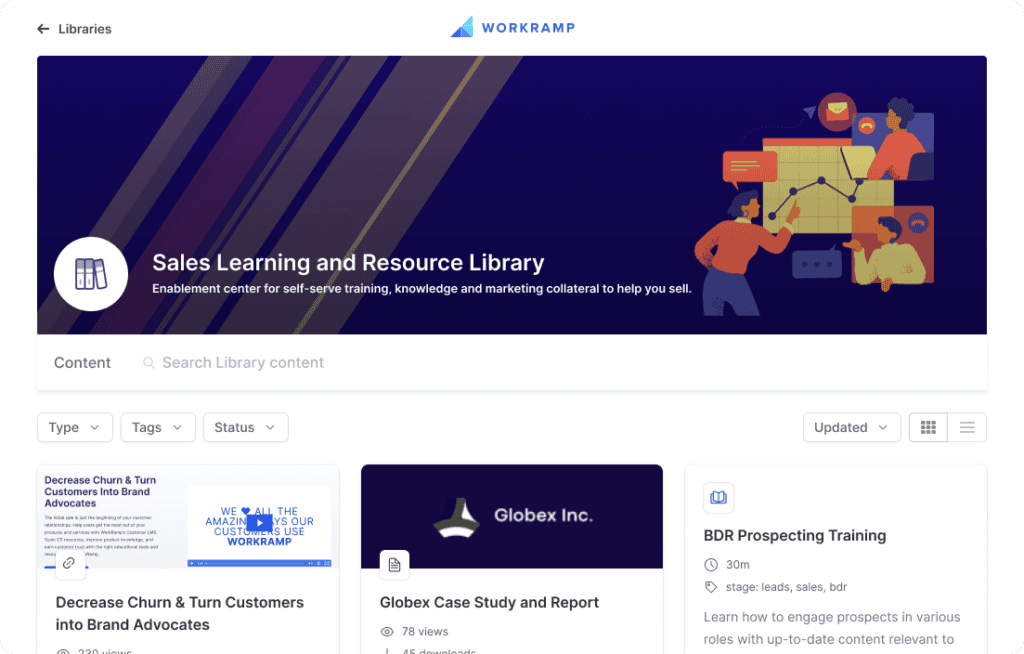
A unified LMS + CMS gives you a one-stop shop for all of your enablement content, training, and programming. Learn more about WorkRamp’s CMS and join the waitlist to be notified when it’s available in early 2024.
How do you create sales enablement content?
Sales enablement starts with your ideal customer profile (ICP), so you can pick a strategy that targets their unique pain points. Then, follow the steps below to create effective sales enablement content to empower your reps to close more deals.
Identify your buyer personas
You may already have buyer personas, but it’s worth checking if your profiles are as detailed as possible. After writing the personas, you may have learned more about your customers’ needs. If you have existing customers, you can build your personas from the knowledge you have of your existing customers’ everyday lives and pain points.
If you’re starting from scratch, you’ll have to research your ICP. Start with a niche and decide what kind of people in that industry or lifestyle would need your product or services.
Ask yourself the following questions:
- Where do they work?
- What is their job title?
- What are their interests?
- What is their family life like?
- What pain points are related to your product?
Decide what will influence your prospects
Once you know what makes your ideal customer tick, you can decide which sales enablement content would influence prospects the most.
For example, suppose your ideal customer is a wellness company that needs your project management software to organize their team’s new product launch. In that case, you might need case studies, customer success stories, pricing options for them to review, and a sales script and slide deck to illustrate how your project management software will organize their team’s work by project, team member, and product.
Talk to sales reps
Remember that your sales reps are an untapped resource for determining the types of enablement content your team needs. They can provide invaluable insight into the resources they need to help them understand your product, address customer concerns, answer questions, and close deals.
Your reps also communicate directly with customers and prospects so they may know pain points or product benefits that should be addressed in your enablement materials.
Map your enablement content to the customer journey
Having the right sales enablement content is only half the battle. You also must ensure your reps have the content they need at the right time. Create a map of the customer journey and use this to determine which materials are most helpful and effective during each stage of the process.
For example, battle cards, which we describe below, may be helpful during the consideration phase when a prospect compares the features, benefits, and price of your product vs. competitors.
Read more: Aligning Sales and Marketing for the Evolving Buyer’s Journey
Create a sales enablement strategy to help your team close the deal
This is where internal sales enablement content and external enablement content meet. Suppose you know which enablement materials will be most beneficial for your team. In that case, you can decide on a sales strategy that will target potential customers with the attributes of your personas (high-quality leads). Your sales enablement strategy is essentially your sales organization’s approach to distributing the marketing materials to your reps and deciding how you will measure success.
Suppose you know which enablement materials will be most useful for your team. In that case, you can decide on a sales strategy that will target potential customers with the attributes of your personas (high-quality leads). Your sales enablement strategy is essentially your sales organization’s approach to distributing the marketing materials to your reps and deciding how you will measure success.
You’re creating an environment that encourages sales professionals to use the resources for their benefit.
Here’s a high-level overview of how to set up your sales enablement strategy:
- Pick specific goals and KPIs (number of calls made, conversions, revenue goals, etc.)
- Establish a sales enablement team to train your reps on the use and importance of enablement materials
- Track conversions and customers in a centralized place like a customer relationship management (CRM) tool
- Give your team the right sales enablement tools to do their best work (data tracking software, CRMs, LMSs, prospecting tools, etc.)
- Make your sales enablement materials accessible to your whole team
- Train your sales reps to use the tools or software you’ve given them to track and complete conversions
- Follow up with team members regularly to offer support and learn what works for them
- Analyze the conversion data to understand which sales enablement materials work and adapt as needed
With the right content, tools, and a clear strategy, you can refine your enablement resources and generate more revenue through a targeted approach to your customer’s pain points.
Types of sales enablement content to maximize deals
The truth is sales enablement materials are not one size fits all for every company or sales professional. Various enablement tools serve different purposes, so you’ll want to get familiar with them so you can offer your team the most fitting resources for their work and customers.
Internal sales enablement content: empower your team
These are the resources your team will use internally but will not share with current customers or prospects.
Sales onboarding and training
The best sales enablement starts on day one with your organization. Your sales onboarding and training should incorporate the best internal sales enablement content your organization has, and it should be updated regularly as new best practices are discovered and vetted.
Buyer personas
A buyer persona describes your ideal customer so that your sales reps know who to focus on during prospecting. It’s based on the patterns you discover while researching your most profitable customers.
The persona also describes the ideal customer’s pain points so your reps can target the sales conversation, share the right sales assets, and maximize their chance of closing a deal.
Talk tracks
A talk track is an abbreviated sales script that allows experienced sales reps to stay on track during a conversation without sounding robotic, rehearsed, or memorized.
It can be a helpful cheat sheet when sales reps encounter complex objections or need to confidently discuss product details.
Sales scripts
A sales script gives newer sales reps a fully fleshed-out dialogue that allows them to share all relevant information about how your solution helps the lead with their most pressing problems. However, it’s important for sales reps to practice sounding natural when using scripts—leads may not take them seriously if the conversation feels unnatural.
Sales scripts are also helpful for leaving voicemails so the reps don’t forget any important information.
Sales playbooks
A sales playbook is a guide that gives reps information about how to handle different situations based on best practices the company has developed over time. The playbook makes it easier for reps to personalize the call without spending tons of time looking for sales assets and pricing sheets. A sales playbook also ensures every lead has a consistent experience with your organization, which can make a big difference in customer satisfaction.
Competitor research
Understanding your competitors can help sales reps know how to position your solution appropriately.
Competitor research can educate reps on competitors’ key talking points, core benefits you address that others don’t, and more. When reps find out a lead has talked to another company, they can use competitor research to tailor the conversation accordingly.
Battlecards
Battlecards are a concise way to package competitor research alongside key product information, targeted pain points, and your organization’s value proposition. As a result, they can be used as a talk track, built into a sales playbook, or used as a standalone resource.
Battle cards can be used for effective pitching, to stay ahead of competitors the lead is talking to, and to practice for specific sales situations.
Product demo script or flowchart
When a sales rep walks a lead through a demo, it’s important to sound confident, knowledgeable, and on top of every detail. That’s where a product demo script or flowchart comes in. Knowing exactly what to say and having key information at hand lowers the stress reps feel and helps them listen more effectively to the customer rather than trying to remember the next steps of the demo.
Demo scripts also help improve consistency and increase demonstration efficiency.
Win/loss stories
These stories are a bit like testimonials, but instead of featuring customers, they feature sales reps talking about how they won or lost specific deals. Capturing this information, ideally on video, gives your team valuable insight and allows you to leverage peer-to-peer learning.
External sales enablement for customers
These are resources your reps can distribute or use on customer calls.
Slide decks
Slide decks help sales reps provide a visual presentation to show prospective customers why they should be interested in your product or service.
Slide decks should be easy to customize for the customer’s needs and core pain points; otherwise, reps will be less likely to use the deck.
Read more: The Essentials of a Compelling Sales Pitch + Examples
Case studies
Case studies allow happy customers to speak for you. Case studies offer data, stories, and other demonstrations of how your solution benefits customers.
This builds credibility and trust and offers customers a reliable source. Case studies can also be produced in various formats: video, written text, slideshows, infographics, and more. This makes them easy to use in direct conversations with leads, on social media, through email, and on your website.
One-pagers
Today’s buyers are busy. One of the best ways to reach them is by having sales materials that are concise and easy to understand, and that’s where one-pagers come in.
One-pagers can be tailored to various audiences: customers, partners, or even potential investors. A one-pager explains to a specific audience exactly why they should be interested in your organization and what they should do next.
Email templates
Email templates are technically kept in-house, but once they’re fleshed out and personalized, they’re sent to customers, so we’re counting them as external sales content. Having pre-formatted email content that sales reps can adapt to send to a lead makes it easy for reps to maintain contact with prospects and send them sales quotes, specific product information, and more.
White papers
A white paper is an in-depth, factual report demonstrating your organization’s expertise in your industry.
Often, white papers are about a specific problem your customers experience and showcase how your product or service solves the problem. This type of sales enablement content establishes your company as an authority iand gives customers insights into how to address key issues.
eBooks
An eBook is a short digital book, usually 3,000 words or so. It can be used as a lead magnet to encourage leads to join your email list, as a freebie for ideal customers, or as part of an informational packet a sales rep sends with a pitch for the product or service. eBooks are an excellent resource for sales reps and can also be used to address specific questions or answer FAQs.
Blog posts
A blog post is marketing content, but it can also be sales content when reps use it to answer questions, build trust, and educate leads about how your solution can help them.
At the same time, blogs build brand awareness and help generate demand for your product or service.
Customer testimonials
Testimonials are different from case studies, which were mentioned earlier. Case studies are in-depth and focus on how a customer experienced a specific problem, implemented your solution, and saw unique results.
A testimonial is shorter, delivered directly by the customer, and discusses how your product or service helped them achieve better results.
Webinars
Webinars are great sales enablement content because they highlight the effectiveness of your solution, often by emphasizing the expertise of subject matter experts (SMEs) within the company.
This boosts your organization’s credibility, and webinars can be recorded or live. A recorded webinar can be watched on demand or repurposed as a blog post or video snippets for social media. A live webinar boosts leads’ engagement and allows potential customers to ask questions in real time.
Building the right sales enablement content for your team
With the sales enablement material options you have at your disposal and a strategy that targets your ideal customer, you can empower your team to generate revenue, close deals, and feel confident in their product knowledge.
You may notice increased collaboration among your team members, a renewed focus on your sales goals, and more time spent on the work that drives revenue.
Training your team to use your sales enablement content may seem daunting or overwhelming, but a sales enablement platform can help to make the training process easier. With an All-in-One Learning Platform like the Learning Cloud, you can optimize training for current and new employees to use each type of enablement content at the right stage of the buyer’s journey while remaining consistent across all sales teams.
WorkRamp can help you provide training programs that coach your reps on product knowledge and sales tactics to help increase win rates. You can also build a resource center that allows your team to learn wherever and whenever with a self-service library of training courses.
Want to learn more about using WorkRamp to create on-demand training to increase rep efficiency, drive revenue performance, and close more deals? Contact us to schedule a free, personalized demo.
Complete the form for a custom demo.
Recent Posts
- Why Secure LMS Platforms Are a Must for Regulated Industries July 10, 2025
- Top LMS Integrations That Power Smarter, Faster Learning July 2, 2025
- Introducing WorkRamp Analytics Studio: Unlocking Your Data Insights with AI June 30, 2025
- 11 AI LMS for AI-Powered Learning June 27, 2025
- The Best LMS Platforms for Customer Retention (2025 Guide) June 27, 2025
Maile Timon
Maile Timon is a Copywriter and Content Strategist with 10+ years of experience writing for B2B and B2C brands. She creates thought leadership and SEO-optimized content and short- and long-form copy for websites, landing pages, email campaigns, and more. Follow Maile on LinkedIn.
You might also like
3 essential sales enablement tools
Too many tools can be distracting for reps. Here are the enablement tools you really need to achieve sales goals.
Read More
Why Enablement Should Be at the Executive Table
Enablement is critical to the success of your organization. In fact, research shows that organizations with a sales enablement function have way higher win rates than organizations that don’t. So why don’t we always have a seat at the executive table?
Read More
6 Sales Onboarding Best Practices
Take your onboarding to the next level using these sales onboarding best practices from enablement leaders at WorkRamp, Divvy, Zoom, and Handshake.
Read More
Decrease Ramp Time and Increase Revenue
Get in touch to learn how WorkRamp can help you achieve your learning and development goals.
Request a Demo